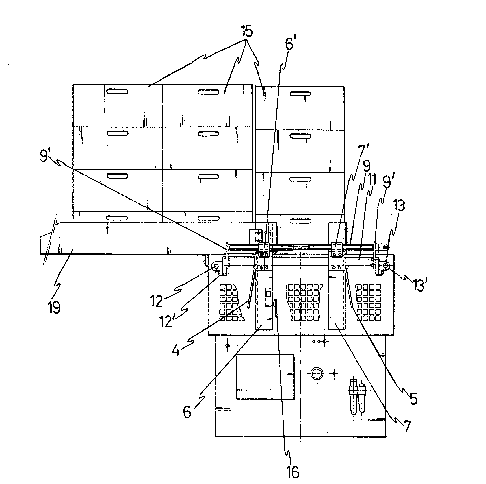Some of the information on this Web page has been provided by external sources. The Government of Canada is not responsible for the accuracy, reliability or currency of the information supplied by external sources. Users wishing to rely upon this information should consult directly with the source of the information. Content provided by external sources is not subject to official languages, privacy and accessibility requirements.
Any discrepancies in the text and image of the Claims and Abstract are due to differing posting times. Text of the Claims and Abstract are posted:
| (12) Patent Application: | (11) CA 2082447 |
|---|---|
| (54) English Title: | BOX STACKER |
| (54) French Title: | EMPILEUR DE BOITES |
| Status: | Deemed Abandoned and Beyond the Period of Reinstatement - Pending Response to Notice of Disregarded Communication |
| (51) International Patent Classification (IPC): |
|
|---|---|
| (72) Inventors : |
|
| (73) Owners : |
|
| (71) Applicants : |
|
| (74) Agent: | MARKS & CLERK |
| (74) Associate agent: | |
| (45) Issued: | |
| (22) Filed Date: | 1992-11-09 |
| (41) Open to Public Inspection: | 1994-01-15 |
| Availability of licence: | N/A |
| Dedicated to the Public: | N/A |
| (25) Language of filing: | English |
| Patent Cooperation Treaty (PCT): | No |
|---|
| (30) Application Priority Data: | ||||||
|---|---|---|---|---|---|---|
|
ABSTRACT OF THE DISCLOSURE
This is a box stacker which is related with a box shaping
machine. The boxes come out at the bottom of the machine and
drop by gravity onto a conveyor belt (2) and are conveyed to one
end of this belt (2) where the stacker which is object of this
invention is located. It has upright adjustable guides, two in
front (4 and 5) and two at the rear (6 and 7) which correspond
to the vertical corners of the box, and are at the same time
coupled in pairs to two cross shanks (8 and 9) respectively,
which are in turn coupled at the end to cross shafts (10 and 11)
which are joined by longitudinal screws. The screws turn in
either direction and the upright guides will be adjusted to fit
to the dimensions of the boxes. When one of these lies between
the four upright guides, a pusher (14) goes up and moves the box
to allow room for another one and so on successively. When a
stacked row has been formed, which is automatically counted, it
will be moved by a pusher towards a platform which is formed by
two plates at right angle.
Note: Claims are shown in the official language in which they were submitted.
Note: Descriptions are shown in the official language in which they were submitted.

2024-08-01:As part of the Next Generation Patents (NGP) transition, the Canadian Patents Database (CPD) now contains a more detailed Event History, which replicates the Event Log of our new back-office solution.
Please note that "Inactive:" events refers to events no longer in use in our new back-office solution.
For a clearer understanding of the status of the application/patent presented on this page, the site Disclaimer , as well as the definitions for Patent , Event History , Maintenance Fee and Payment History should be consulted.
| Description | Date |
|---|---|
| Inactive: IPC deactivated | 2017-09-16 |
| Inactive: First IPC from PCS | 2017-01-07 |
| Inactive: IPC from PCS | 2017-01-07 |
| Inactive: IPC expired | 2017-01-01 |
| Inactive: IPC from MCD | 2006-03-11 |
| Application Not Reinstated by Deadline | 1997-11-10 |
| Time Limit for Reversal Expired | 1997-11-10 |
| Deemed Abandoned - Failure to Respond to Maintenance Fee Notice | 1996-11-11 |
| Application Published (Open to Public Inspection) | 1994-01-15 |
| Abandonment Date | Reason | Reinstatement Date |
|---|---|---|
| 1996-11-11 |
Note: Records showing the ownership history in alphabetical order.
| Current Owners on Record |
|---|
| BOIX MAQUINARIA, S.A. |
| Past Owners on Record |
|---|
| JOSE BOIX JAEN |